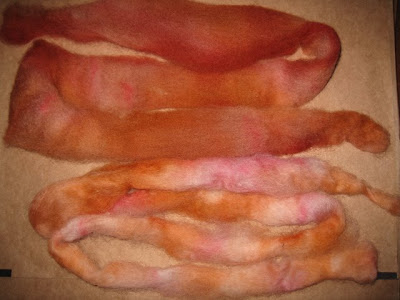HUGE difference. HUGE. To keep it straight, the first lot of hand-combed, dizzed top I dyed, I just put my fat, airy slivers (and wrapped "airy" into bird’s nests) into mason jars “as is.” The second lot, same size bird’s nests, I first unwrapped the nests and re-wrapped them into new bird’s nests, but this time pulling steady tension on the fibers (staying within staple length, but pulling pretty firmly) in order to smooth it out and make it more dense.
In spinning the first day’s lot… definitely some felting went on in there. I can pull it out, it’s not that much felting, but I do have to pull it out as I’m spinning. I had to use a much longer draw. The second day’s lot? It was practically like spinning commercial top! It slipped through my fingers, I didn’t have any sense of tangled fibers within. Spun smoother. And easier.
So for me, I am now pretty willing to go ahead and comb undyed fleece and dye it after. But for sure, use a large-holed diz (maybe even larger than the 3/16ths hole) and even though it's typically super airy, THEN wrap it into bird’s nests with tension on them. I mean, when I re-wrapped those slivers around my fingers yesterday, I did not wrap loosely like you normally would a totally airy sliver. I wrapped it tight, so I was dealing with quite a solid density of fiber. I mean, there was actual shine to it.
Here are some photos. I think you can see the difference.
The two together outside

The two together, different light, inside

Here's a close-up of the 1st try (with the fiber left airy, right off the diz but bird-nested before putting into mason jars).

First of all, the above ended up drying as WAY thinner top than it started. (These are exactly the same sized diz-ing). What happened, I'm convinced, is that by NOT pulling it into a denser, condensed sliver, it did its own condensing in the dye bath. That enabled the fibers to hug together however they landed. And, of course, it dried in the same self-condensed form it took condensing on its own when floating in the dyebath water. The result was, in effect, some felting.
Now here is a close-up of the 2nd try. Any condensing that was going to take place, I did prior to putting those bird's nests into the mason jars and pouring the dyebath into them (same exact method as above). I did not do any attenuating! I simply pulled the sliver flat and smooth by staying within its staple length as I RE-wrapped it from its airy bird's nests into smoother, condensed bird's nests.

Closer... As it dried, it fluffed right back up BUT! with the fibers still aligned.

Closest. You can see the alignment of the fibers here. Pretty darned straight! The fuzzy part you see here is not felting, just a thinner spot or an end. This spun up like butter!

Color Variation for blending 3 colors together:
Since I did get way too little color variation (used 3 colors just like originally on Dye Day (see that post) when I was using commercially-combed top, this could be due to one of two things. First, I used more dye powder here than I should have, that can cause mud. But secondly, and I'm sure this had something to do with it even if the dye amount was too much... it's standing to reason that if you want a blended multi-colored top out of mason jars (as opposed to the colors just mixing) then I already know you have to pack the jar pretty tight. Well, with hand-dizzed top, even if you condense it as above, it's STILL going to be a looser, less dense top. So that's telling me that MANY bird's nests have to be crammed in that jar, one on top of the other... like a LOT. Whereas with commercial top, you can pack it so a poke has one degree of resistance, it'll take some experimenting to get the same amount of fiber packed in with hand-dizzed. I'm now thinking to help in that, it would make sense to wad some screening onto the very top of these hand-dizzed bird's nests to hold them tighter than I suspect they'll be able to remain otherwise. I know that on both days' experiments, when I was done steaming, the fiber was popping out of the jars somewhat. That didn't happen with the commercially combed top. It started dense, and just got denser when wet. So something artificial added has to hold this down tight. A pusher of some kind.